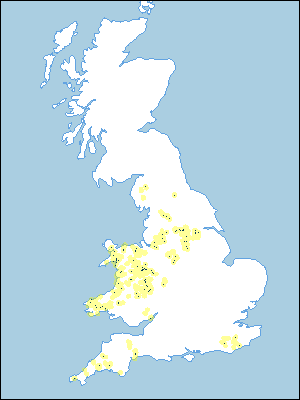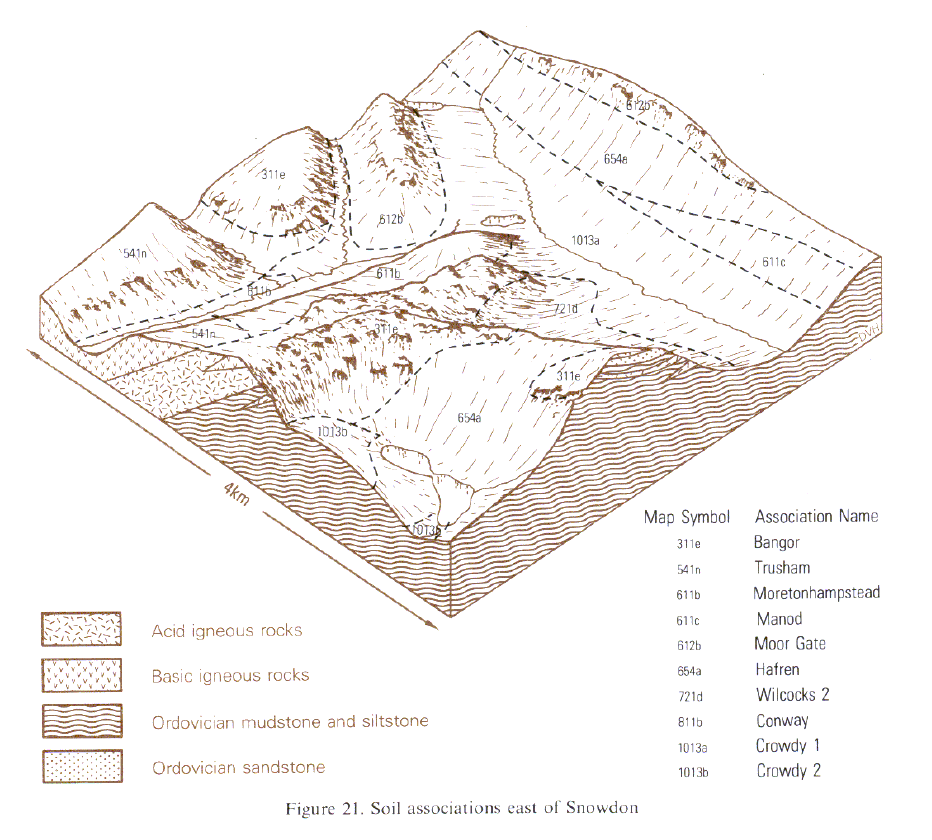
Soil Associations
0811b CONWAY
Soil and site characteristics
Deep stoneless fine silty and clayey soils variably affected by groundwater. Flat land. Risk of flooding.
Geology
River alluvium
Cropping and Land Use
Dairying and stock rearing on permanent grassland.
Component soil series
| Subgroup | Series name | Percentage | WRB 2006 link |
|---|---|---|---|
| 8.11 | CONWAY | 50% | Fluvic Eutric Gleysols |
| 5.62 | CLWYD | 20% | Siltic Fluvic Gleyic Cambisols |
| 8.13 | FLADBURY | 15% | Clayic Fluvic Eutric Gleysols |
Covers 672 km2 in England and Wales
Soilscapes Classification
| 20 |
Loamy and clayey floodplain soils with naturally high groundwater |
0811b CONWAY
Detailed Description
Deep stoneless fine silty soils dominate this association which is found on the floodplains of rivers and streams. The soils are usually greyish brown or grey with yellowish brown mottles and are affected by high groundwater levels. Browner soils occur where the water-table is lower. The association occurs in nearly all parts of England and Wales, as strips along major valley floors. Altitudes range from near sea level to about 260 m O.D. in central Wales. Fine silty typical alluvial gley soils, Conway series, dominate the association. Similar fine loamy Enborne, coarse loamy Eversley and coarse loamy over gravelly Kettlebottom soils (Clayden and Hollis 1984) occur locally. Clayey Fladbury series (pelo-alluvial gley soils) and fine silty gleyic brown alluvial soils of the Clwyd series are common whilst the fine loamy Trent series and the well drained Teme series are occasional, especially on levees. Wetter soils of the Dovey series (Clayden and Hollis 1984) with peaty or, more often, humose topsoils are found in places in western Britain. Peat soils are rare, although important in places. Gravelly subsoils are common where there has been torrential alluvial deposition, usually in upper reaches of the rivers. The association covers just over 200 km² mainly along the valleys of the Dove, Dane, Mersey, Arrow, Lugg and Severn in eastern Staffordshire, north Cheshire and the Welsh Borderland. In the southern Welsh Borderland the Conway series was formerly called Kingsland series (Hodgson 1972). Conway soils are extensive on the Severn floodplain upstream from the Ironbridge Gorge and particularly widespread west of Shrawardine in Shropshire. In the Welsh Borderland this association marks the sites of several former pro-glacial lakes notably at Woofferton, Wigmore and Letton. Here the main associated soil is Fladbury series. Narrow strips of Clwyd soils (formerly Cummins series; Palmer 1976) are often found on levees adjacent to the rivers where groundwater levels are lower than further away from the streams. In places where tributary streams drain red country rock they bring reddish alluvium onto the main floodplain giving small areas of Compton soils. In the Dove, Dane and Mersey valleys of Staffordshire and Cheshire some of the alluvium is fine loamy and contains lenses of peat so Enborne series is the most widespread subsidiary soil. In hollows and old meander channels, persistent waterlogging has favoured the formation of peat so Dovey soils with humose topsoils and Midelney soils with thin clayey alluvium overlying peat are common. The association covers nearly 300 km² in Wales, the largest area being in the Severn valley between Shrewsbury and Welshpool. Part of this is described in detail by Thompson (1982). It is also found along the valleys of the Conwy, Glaslyn, Mawddach, Dee, Dovey, Rheidol, Ystwyth, Aeron and Teifi, and many smaller rivers and streams. It is mostly absent from the Old Red Sandstone areas of Dyfed, Powys and Gwent where the river valleys have reddish alluvium. The better drained Clwyd series occurs in many valleys, especially on low levees near the main rivers. Clayey profiles of the Fladbury series are also frequent, especially in the Severn valley and in South Dyfed. The Dovey series is more common in Wales than elsewhere, as in parts of the Aran valley near Dolau. Gravelly alluvial soils although uncommon are sometimes included as in the Ystwyth and Rheidol valleys of north Dyfed (Rudeforth 1970). Peat soils are included in places with larger areas in the valleys of the Cefni (Anglesey), Conwy, Glaslyn and Dwyryd (Gwynedd), Gwaun, Dovey, Aeron and Teifi (Dyfed), and in Burton Meadows between Wrexham and Chester.
The association occupies some 34 km² in Cornwall, Devon and Somerset mostly along rivers draining slaty Devonian rocks. Although soils of this association are found in many valleys, most occurrences are too narrow to show on the map. The main areas are in the broadest sections of the valleys of the Fowey, Otter, Lynher, Tamar and Exe. There is a small strip along the river Tale which drains Permo-Triassic rocks in east Devon.
The association covers 85 km² in Northern England from near sea level to 120 m O.D. It is found on the floodplains of the Aire, south-east of Leeds, of the Calder around Wakefield, and downstream from the confluence of the two rivers. It is also in the Dearne valley around Clayton West and between Darfield and Mexborough, in the Don valley north of Stainforth and in the Went valley east of the Magnesian Limestone. In North Yorkshire, the association occurs on the Aire floodplain from Airton to Glusburn, in Ribblesdale from Giggleswick to Halton West and at the head of the Wenning south of Clapham. In the Lake District the alluvium between Derwent Water and Bassenthwaite Lake is dominated by Conway soils, as is flat land at Mungrisdale. Clwyd soils are frequent whilst Enborne soils occur on the Aire floodplain near Steeton and in the Went valley. Coarse and fine loamy typical brown alluvial soils, the Alun and Wharfe series respectively, are in former stream channels or on levees or level narrow strips of ground close to meandering rivers. Small areas of peat soils occur near Austwick and north of Newsham.
The association is of small extent in South East England in the upper valleys of the Medway, Rother, Brede and Ouse, which rise in the mainly silty and fine sandy rocks of the High Weald. Conway soils are dominant overall, but in the Ouse valley the drier Clwyd soils are equally abundant. Teme soils are common in the Rother valley, often on low levees. Enborne soils occur locally in the Medway floodplain, which also has rare Fladbury soils.
Soil Water Regime
Conway and Fladbury soils are seasonally waterlogged (Wetness Class IV), though Fladbury series in backswamps can be severely waterlogged (Wetness Class V). The Clwyd series is seasonally waterlogged (Wetness Class III) but may be improved by underdrainage (Wetness Class II).
Cropping and Land Use
Winter floods are common and summer flooding also occurs in many areas after heavy rain. This with the high groundwater-table and the difficulty of working wet fine textured soils precludes arable cropping so most of the association is under permanent grass with a little rough grassland and scrub. High groundwater levels and soft wet topsoils lead to a serious risk of poaching especially early and late in the year although field drainage can reduce the risk to some extent. The wildlife habitats provided by the wetter land within the association are becoming increasingly rare with the extension of field drainage. In low backswamps, farthest from the river, field drainage is sometimes prohibitively expensive so these areas can be usefully managed for conservation of wildlife.
0811b CONWAY
Distribution Map
 |
Note that the yellow shading represents a buffer to highlight the location of very small areas of the association.
Keys to component soil series
South Eastern Region
 |
Midlands
 |
Northern Region
 |
Wales
 |
Typical Landscapes
South Western Region
 |
Wales
 |
Wales
 |
Midlands
 |
South Eastern Region
 |
South Eastern Region
 |
All information Copyright, Cranfield University © 2025
Citation: To use information from this web resource in your work, please cite this as follows:
Cranfield University 2025. The Soils Guide. Available: www.landis.org.uk. Cranfield University, UK. Last accessed 25/04/2025
